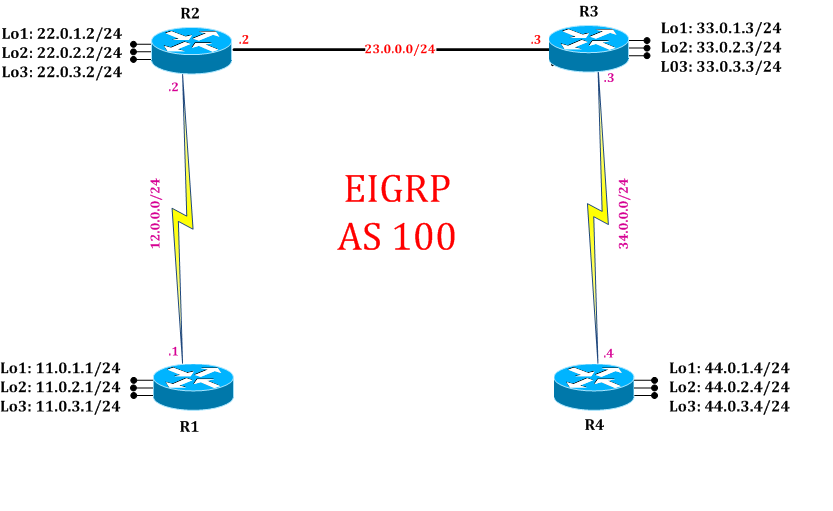EIGRP IPv4 - Passive Interface
Passive Interface
EIGRP (Enhanced Interior Gateway Routing Protocol) IPv4 Passive Interface is a configuration option that allows network administrators to control a router's participation in EIGRP routing updates on specific interfaces. When an interface is marked as passive, the router neither sends EIGRP routing updates out of that interface nor actively participates in forming neighbor relationships on that link. However, the router still listens to incoming EIGRP updates on the passive interface. This feature is particularly useful in scenarios where certain interfaces should not contribute to EIGRP routing, such as interfaces connected to stub networks or links leading to non-EIGRP domains. By configuring interfaces as passive, administrators can reduce unnecessary EIGRP traffic, optimize network resources, and enhance overall network efficiency. EIGRP IPv4 Passive Interface is a valuable tool for tailoring the EIGRP routing process based on the specific requirements and topology of the network.
Lab:
Disclaimer
This Configuration Guide is designed to assist members to enhance their skills in particular technology area. While every effort has been made to ensure that all material is as complete and accurate as possible, the enclosed material is presented on an Dzas isdz basis. Neither the authors nor Forum assume any liability or responsibility to any person or entity with respect to loss or damages incurred from the information contained in this guide. This configuration guide was developed by Forum. Any similarities between material presented in this configuration guide and any other material is completely coincidental.
Cisco IOS Software, Linux Software (I86BI_LINUX-ADVENTERPRISEK9-M), Version 15.2(4)M1, DEVELOPMENT TEST SOFTWARE

Task 1: Configure IPv4 EIGRP process with Passive interface
Step 1: In the configuration mode of router configure EIGRP process using network 0.0.0.0 by following command
R2:
router eigrp 100
network 0.0.0.0 (send updates on all the interfaces)
exit
Step 2: Suppress EIGRP updates using “passive-interface” command and “passive-interface default” command
R2:
router eigrp 100
passive-interface loop3
exit
After suppressing EIGRP updates on Loopback 3 by using passive-interface command, Lo3 is suppressed and not been seen.
R2#show ip eigrp interface
EIGRP-IPv4 Interfaces for AS(100)
Xmit Queue PeerQ Mean Pacing Time Multicast Pending
Interface Peers Un/Reliable Un/Reliable SRTT Un/Reliable Flow Timer Routes
Lo1 0 0/0 0/0 0 0/0 0 0
Lo2 0 0/0 0/0 0 0/0 0 0
Se2/0 1 0/0 0/0 16 0/16 92 0
Et0/0 1 0/0 0/0 6 0/2 50 0
R2:
router eigrp 100
passive-interface default
exit
After suppressing EIGRP updates by using passive-interface default command, all interface is suppressed and not been seen.
R2# show ip eigrp interfaces
EIGRP-IPv4 Interfaces for AS(100)
Xmit Queue PeerQ Mean Pacing Time Multicast Pending
Interface Peers Un/Reliable Un/Reliable SRTT Un/Reliable Flow Timer Routes
Step 3: Un-suppress EIGRP updates using “no passive-interface” command
R2:
router eigrp 100
no passive-interface default
exit
After un-suppressing EIGRP updates using no passive-interface default command, all interfaces are un-suppress and are seen in eigrp interface table.
R2# show ip eigrp interfaces
EIGRP-IPv4 Interfaces for AS(100)
Xmit Queue PeerQ Mean Pacing Time Multicast Pending
Interface Peers Un/Reliable Un/Reliable SRTT Un/Reliable Flow Timer Routes
Se2/0 1 0/0 0/0 17 0/16 100 0
Et0/0 1 0/0 0/0 9 0/2 50 0
Lo1 0 0/0 0/0 0 0/0 0 0
Lo2 0 0/0 0/0 0 0/0 0 0
Lo3 0 0/0 0/0 0 0/0 0 0
Task 2: Verification: Step 1: Verify EIGRP neighborship by following command:
R2#show ip eigrp neighbors
EIGRP-IPv4 Neighbors for AS(100)
H Address Interface Hold Uptime SRTT RTO Q Seq
(sec) (ms) Cnt Num
1 23.0.0.3 Et0/0 12 00:16:57 9 100 0 7
0 12.0.0.1 Se2/0 12 00:17:43 17 102 0 5
Step 2: Verify routing table and EIGRP routes by following command:
R2#show ip route
Codes: L - local, C - connected, S - static, R - RIP, M - mobile, B - BGP
D - EIGRP, EX - EIGRP external, O - OSPF, IA - OSPF inter area
N1 - OSPF NSSA external type 1, N2 - OSPF NSSA external type 2
E1 - OSPF external type 1, E2 - OSPF external type 2
i - IS-IS, su - IS-IS summary, L1 - IS-IS level-1, L2 - IS-IS level-2
ia - IS-IS inter area, * - candidate default, U - per-user static route
o - ODR, P - periodic downloaded static route, H - NHRP, l - LISP
+ - replicated route, % - next hop override
Gateway of last resort is not set
11.0.0.0/24 is subnetted, 3 subnets
D 11.0.1.0 [90/2297856] via 12.0.0.1, 00:21:10, Serial2/0
D 11.0.2.0 [90/2297856] via 12.0.0.1, 00:21:10, Serial2/0
D 11.0.3.0 [90/2297856] via 12.0.0.1, 00:21:10, Serial2/0
12.0.0.0/8 is variably subnetted, 2 subnets, 2 masks
C 12.0.0.0/24 is directly connected, Serial2/0
L 12.0.0.2/32 is directly connected, Serial2/0
22.0.0.0/8 is variably subnetted, 6 subnets, 2 masks
C 22.0.1.0/24 is directly connected, Loopback1
L 22.0.1.2/32 is directly connected, Loopback1
C 22.0.2.0/24 is directly connected, Loopback2
L 22.0.2.2/32 is directly connected, Loopback2
C 22.0.3.0/24 is directly connected, Loopback3
L 22.0.3.2/32 is directly connected, Loopback3
23.0.0.0/8 is variably subnetted, 2 subnets, 2 masks
C 23.0.0.0/24 is directly connected, Ethernet0/0
L 23.0.0.2/32 is directly connected, Ethernet0/0
33.0.0.0/24 is subnetted, 3 subnets
D 33.0.1.0 [90/409600] via 23.0.0.3, 00:20:19, Ethernet0/0
D 33.0.2.0 [90/409600] via 23.0.0.3, 00:20:19, Ethernet0/0
D 33.0.3.0 [90/409600] via 23.0.0.3, 00:20:19, Ethernet0/0
34.0.0.0/24 is subnetted, 1 subnets
D 34.0.0.0 [90/2195456] via 23.0.0.3, 00:20:19, Ethernet0/0
44.0.0.0/24 is subnetted, 3 subnets
D 44.0.1.0 [90/2323456] via 23.0.0.3, 00:19:39, Ethernet0/0
D 44.0.2.0 [90/2323456] via 23.0.0.3, 00:19:39, Ethernet0/0
D 44.0.3.0 [90/2323456] via 23.0.0.3, 00:19:39, Ethernet0/0